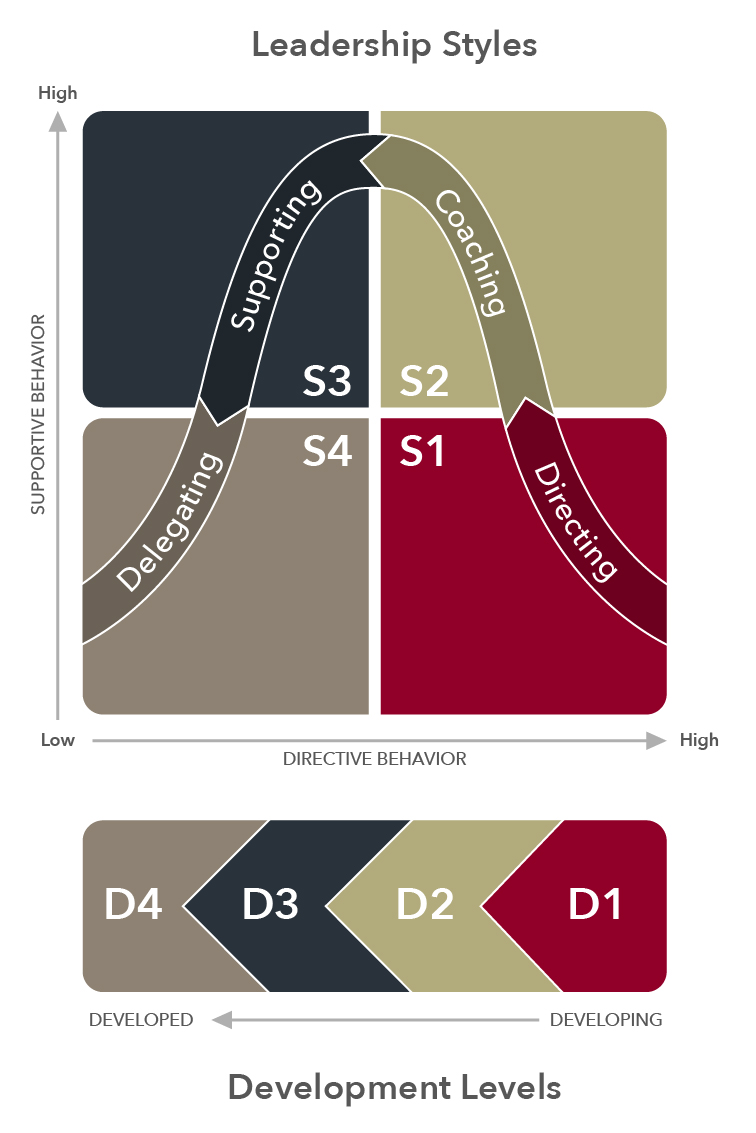Rather than choosing a preferred leadership method, it’s important to acknowledge that different leadership strategies work better in different situations. The situational approach was developed by Hersey and Blanchard and eventually adapted into a Situational Leadership® model to focus on leadership styles in different situations.
What is Situational Leadership?
Situational leadership is a discipline that leaders should use to get the most out of their team and employees; it’s based on prescribing different methods of leadership based upon the developmental stages of the leader’s followers. A good leader will be able to analyze a situation to determine which elements of leadership they should leverage for maximum impact in a way that motivates and benefits everyone and continually increases performance.
Directive vs. Supportive Behaviors
Both kinds of behaviors should be used depending on the circumstances. After analyzing the needs of the followers and goal, a leader should judge and adapt their style to suit the occasion. They can do that by directing the team as an authority figure—giving orders or instructions, setting deadlines and determining how to achieve the goal; the directive approach is ideal when the priority is linked to more task- or production-related or routine circumstances.
Alternatively, they can take a backseat to allow the team to support the goal through two-way communication, feedback and praise with supportive behaviors. Supportive behaviors benefit leaders who prioritize employee-customer relations like selling and customer service. Most leadership styles utilize a comfortable combination of the two behaviors. Those that study and understand situational leadership know when it’s best to use an authoritative or cooperative attitude to get the best results.

View the model this graphic is based on here.
Development Levels
Development levels indicate the competence and confidence of the followers and determine what kind of leadership styles are necessary to guide them to success. D1 followers are generally new to the organization or task and are eager to try but less competent in the required skills. D2 are still learning the skills necessary to complete the task but are less motivated than they originally were and so lack the proper motivation to succeed. D3 have developed most of the needed skills but may vary in their individual commitment levels. D4 are the most competent and the most committed; they have all the prerequisites to succeed.
High development levels mean that followers are highly capable of succeeding at a task and so require less leadership. Developing level followers have less competence, but have the motivation or confidence to complete the task at hand.
Four Styles of Situational Leadership
Leaders should adapt leadership styles to meet necessary behaviors to motivate followers at varying stages in their development. Leadership: Theory and Practice by Peter Northouse defines each style:
-
Directing Style
This style requires a high directive—low supportive behavior which favors the tasks at hand and the goal they accomplish. This style is most effective with D1 followers.
-
Coaching Style
This style requires a high directive—high supportive behaviors that encourage both the goal and relations within the team. The leader will get involved to provide support, but maintain the executive role in decision-making and the overall process. This style is most effective with D2 followers.
-
Supporting Style
This style requires high supportive—low directive behaviors and so prioritizes letting the team’s strengths direct the progress through the leader’s encouragement and recognition. This style is most effective with D3 followers.
-
Delegating Style
This style requires low supportive—low directive behaviors and relies on assigned roles and tasks to achieve the goal; this leadership style works best for teams who are already motivated and confident in their abilities and responsibilities, or D4 followers.
Advantages & Disadvantages of Situational Leadership
Situational leadership is excellent because it is a prescriptive study—allowing implementers to follow applicable guidelines that are easily adjusted to work as followers develop their skills further. It also provides solutions for each individual as they progress in their development.
According to Leadership Central, however, situational leadership has undergone few studies to determine whether or not it is a truly successful method of leadership. Some criticize that its description of followers’ development levels are too vague and do not properly define commitment or competence levels for each stage. Finally, it does not take important demographics into account like age and gender; other studies have shown that employees who are younger or female are more drawn to supportive behaviors and older and male followers seek more directive behaviors, potentially negating the development process as a whole. More research is needed to evaluate this model’s effectiveness.
How to Use Situational Leadership to Your Advantage
Leaders seeking to improve the quality of their team or followers can use situational leadership to their benefit as well as the benefit of the team. By understanding and responding to the needs of the company and the team with consideration and guidance, everyone can benefit from an increased sense of motivation and skill set. The best results come from a dynamic relationship between leaders and followers that changes to ensure the best results with both product and employee in mind and ensures better results in the future. See how the Public Health Accreditation Board (PHAB) used situational leadership to improve their accreditation process because of the flexibility and framework it provided.